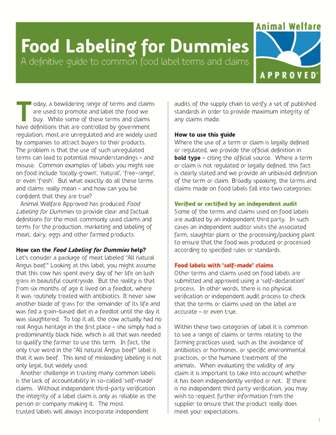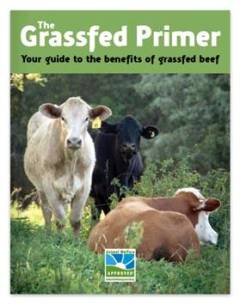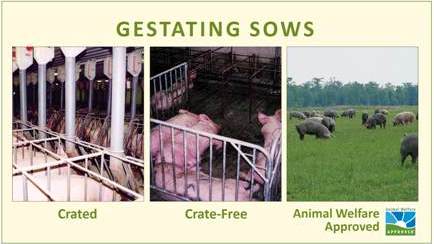What do Food Labels Really Mean?

Food labels are packed with information, but some of the common claims and terms found on food labels can be very confusing – if not downright misleading. For example, a dozen eggs in a carton boasting the statement, “natural” can legally come from an industrial farm where hens are permanently confined, fed antibiotics and never see a blade of grass – much less roam and forage the way a chicken does “naturally.”
So how do you know if a food label is accurate – or even true? Fortunately some of the terms and claims used on food labels are legally defined. And in some cases the claims are independently audited (as with Animal Welfare Approved, Certified Organic and American Grassfed Association). However, in most cases the terms and claims used on food labels are not verified at all. In such cases you may wish to request further information from the supplier to ensure that the product really does meet your expectations.
To help make sense of the bewildering range of claims and terms, definitions for common claims are provided below. For a comprehensive labeling guide see AWA’s Food Labeling for Dummies, available for free download here. For more information on the benefits of grassfed foods and farming, see AWA’s Grassfed Primer, also available for free download here.
Animal Welfare Approved
Independent third-party certification. Animals are raised outdoors on pasture or range on true family farms with the “most stringent” welfare standards according to the World Society for the Protection of Animals in both 2008 and 2009 reports. The standards are developed in collaboration with scientists, veterinarians, researchers and farmers and incorporate best practice and recent research. Annual audits by experts in the field cover birth to slaughter. Species include beef cattle, dairy cattle, pigs, poultry (chicken, turkey and duck), sheep, goats, rabbits and bison.
Cage Free
No legal or regulated definition. This term is most often applied to egg laying hens, not to poultry raised for meat. As the term implies, the hens are raised without using cages. However, “cage free” does not explain if the birds had access to the outside and the reality is that most “cage free” hens live inside large barns or warehouses in overcrowded, unsanitary conditions (see image below). Practices such as beak cutting are also permitted. No independent third-party verification.
Free-Range/Roaming
Defined for poultry meat only. In order to use “free roaming” or “free range” on a poultry meat label the producer must demonstrate to the USDA that poultry have access to the outdoors. However, the type of outdoor access provided (such as pasture or dirt lot), the length of time animals are required to have outdoor access, and how this is verified is not legally defined, and therefore varies greatly from facility to facility. There is no guarantee that birds actually go outside. When used to describe laying hens and other animals, the terms “free range” and “free roaming” are not legally defined at all, and there is no requirement to demonstrate that birds and animals have even had access to the outside, let alone any reference to other management practices. No independent third party verification.
Grassfed (also “100% Grassfed” or “Grassfed, Grass-Finished”)
Multiple definitions. Truly grassfed animals are fed a diet of grass or other forage throughout their lives and have constant access to pasture or range. They are not given any grain feed, animal byproducts, synthetic hormones, or antibiotics to promote growth or to prevent disease. Unfortunately, some “grassfed” labels do not guarantee that animals were pastured or pasture-raised – for example, farmers using the USDA grassfed logo can confine cattle on feedlots while feeding trucked in cut grass or forage. To ensure animals were not confined look for the American Grassfed Association logo, which verifies a 100 percent forage diet and ensures that animals are raised on pasture with no confinement, no antibiotics and no added hormones. For more information see AWA’s Grassfed Primer, available for free download above.
Heritage
No legal or regulated definition. Heritage foods are derived from traditional breeds of livestock and crops that were bred over time so that they are well-adapted to local environmental conditions and can resist local disease, for example. Heritage livestock breeds generally have slow growth rates and are well-suited for grazing on pasture. However, the term “heritage” does not guarantee that animals were raised outdoors and is not independently verified.
Natural
Defined by the USDA. A product containing no artificial ingredient or added color and is only minimally processed (a process which does not fundamentally alter the raw product) may be labeled natural. The label must explain the use of the term natural (such as – no added colorings or artificial ingredients; minimally processed). As defined by the USDA, the term applies only to how meat from the animal is processed after it has been slaughtered. It is important to note that this commonly used term does not refer in any way to how an animal was raised, so the farming system may have involved feedlot and confinement systems or the routine use of antibiotic growth promoters, for example. No third party verification.
No Hormones Administered/No Added Hormones
Defined by the USDA. Hormones are commonly used in industrial farming to speed up animal growth rates. By law, however, hogs and poultry cannot be given any hormones, so any chicken or pork meat labeled “no added hormones,” must also include the statement, “Federal regulations prohibit the use of hormones.”
No Antibiotics
Defined by the USDA. The terms “no antibiotics added” may be used on labels for meat or poultry products if sufficient documentation is provided by the producer to the Agency demonstrating that the animals were raised without antibiotics. Antibiotics are given to animals, such as cattle, hogs, sheep, and chickens, to prevent or manage diseases. Although the USDA is accountable for proper use of these claims, there is no verification system in place.
Organic
Defined by the USDA. All products labeled as “organic” must meet the USDA’s National Organic Program standards. Certification is mandatory for farmers selling more than $5,000 of organic products a year, and is verified by an accredited certifying agency. In general, organic production limits the use of artificial chemicals, pesticides, hormones, antibiotics, and other inputs. Genetic modification is prohibited. However, organic standards do not strictly define production practices related to space per animal or outdoor access requirements – for example, confinement areas are permitted to fatten organic beef cattle.
Pastured/Pasture-raised
No legal or regulated definition. Implies that animals were raised outdoors on pasture.However, since the term is not regulated or certified, there is no way to ensure if any claim is accurate.
Sustainable
Animal Welfare Approved believes that “sustainable” food and agriculture refers to food production and distribution systems which work in harmony with the natural environment and make the most efficient use of limited natural resources; which ensure high animal welfare standards; which provide a fair and secure income for farming families and workers; and which provide high quality, nutritious and affordable food for consumers. Truly sustainable production systems satisfy the food needs of the present without compromising the ability of future generations to meet their own needs. However, as the term “sustainable” is not legally defined, it can – and is – widely used to on food labels from all kinds of farming systems, including intensive farming.
1007 Queen Street | Alexandria, VA 22314 | Tel: 202-546-5292 (5AWA) |
Fax: 202-446-2151
© 2009 Animal Welfare Approved. All rights reserved.
http://www.animalwelfareapproved.org/consumers/food-labels/


